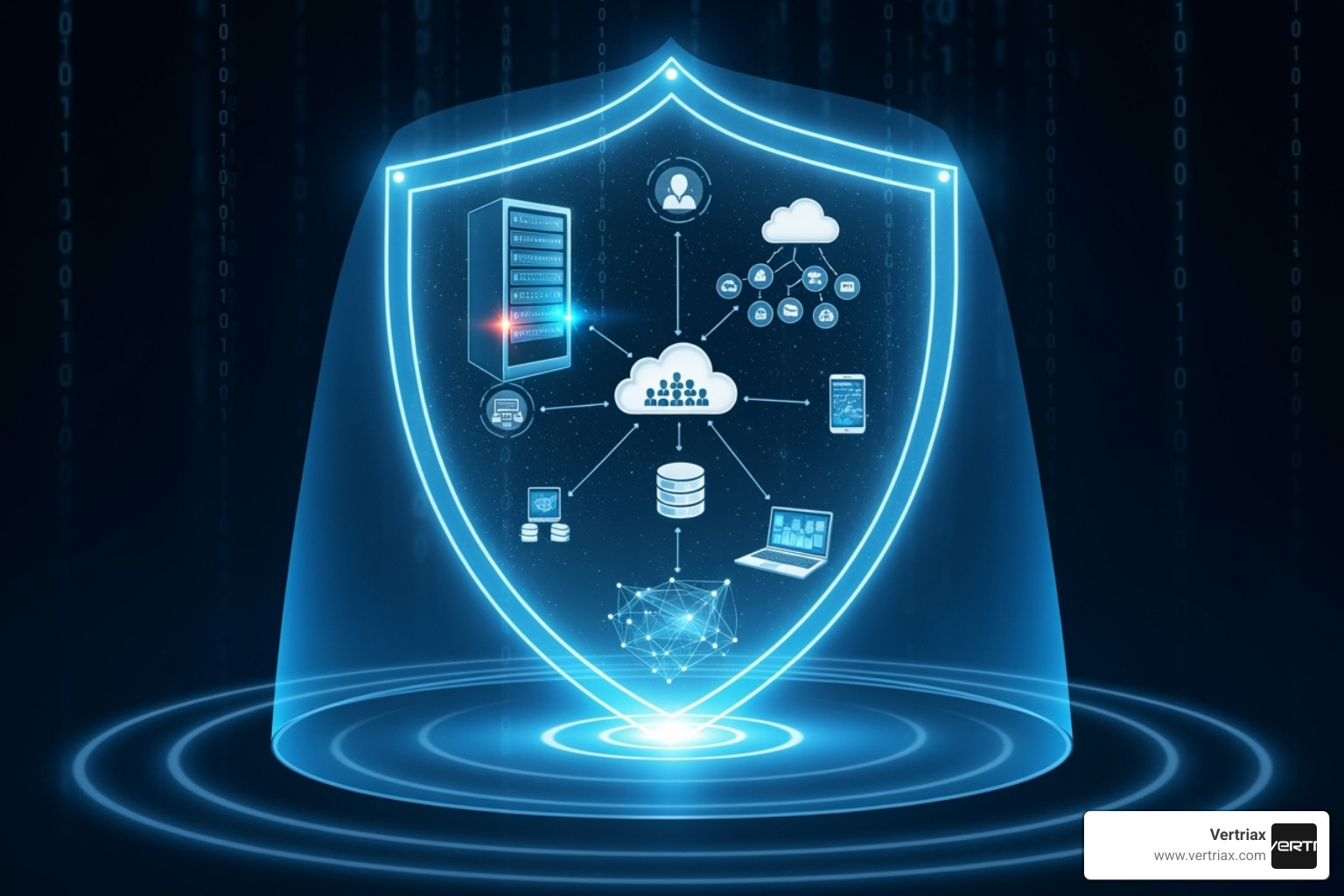Managing Security Like a Boss with Security Operations Management
Why Modern Organizations Are Embracing Security Operations Management

Security operations management is the strategic coordination of people, processes, and technologies to protect an organization's critical assets and infrastructure. This comprehensive approach breaks down traditional silos between IT operations and security teams, creating a unified defense strategy that can adapt to today's rapidly evolving threat landscape.
Key Components of Security Operations Management:
- Planning & Prevention : Risk assessments, security policies, asset inventory, vulnerability management
- Monitoring & Detection : 24/7 network monitoring, threat intelligence, proactive threat hunting
- Response & Recovery : Incident triage, containment, system restoration, post-incident improvements
- Technologies : SIEM, SOAR, XDR, threat intelligence platforms
- Team Structure : Security analysts, incident responders, threat hunters, security engineers
The urgency for robust security operations has never been greater. With over 70% of organizations already beginning their automation journey for SOC operations , companies are recognizing that reactive security can't keep pace with sophisticated cyber threats. The average organization takes 200 days to detect a breach , while cybercriminals leverage AI to make their attacks more effective.
What makes security operations management particularly powerful is its emphasis on collaboration over isolation . As one industry expert noted, the future of SecOps involves organizations recognizing that "IT and security teams need to become more accustomed to seeing each other as allies rather than obstacles" to fully accept the benefits of integrated security operations.
I'm Stewart Smith, and with over 28 years of experience leading security operations management initiatives across 70 countries, I've seen how organizations transform their security posture when they adopt a comprehensive, technology-driven approach. At Vertriax, we've helped hundreds of clients move from fragmented security efforts to unified, proactive defense strategies that actually work.
What is Security Operations Management and Why is it Crucial?
Imagine trying to protect a busy city with security guards who can't talk to each other. That's what happens when organizations treat security and IT operations as separate functions. Security operations management changes this by creating a unified command center where security and IT teams work together to protect an organization's critical assets through continuous monitoring, threat detection, and incident response.
The old way—where security teams focused on safeguarding and compliance while IT teams prioritized speed and agility —created friction and left dangerous gaps. Modern security operations management breaks down these barriers by establishing a security-first mindset that weaves protection directly into every IT process, ensuring business continuity is strengthened, not just maintained.
The Core Goals of a SecOps Strategy
An effective security operations management strategy is built around protecting what matters most. At its heart is the CIA Triad — Confidentiality, Integrity, and Availability —which guides all security decisions.
- Confidentiality : Ensures sensitive information stays in the right hands through robust access controls.
- Integrity : Keeps data accurate and trustworthy by protecting it from unauthorized changes.
- Availability : Guarantees that systems and services remain accessible when needed to drive business value.
Beyond the triad, threat detection and vulnerability management create a proactive defense, while a strong incident response plan ensures swift action when attacks occur. This is all driven by continuous improvement and business alignment , ensuring security efforts support organizational objectives.
Key Benefits of Implementing a Robust SecOps Framework
Adopting strong security operations management delivers tangible improvements across the business:
- Improved security posture : Unifying technologies and operations leads to earlier threat identification and reduced breach risk.
- Faster incident response times : Integrated tools and collaborative teams slash Mean Time to Respond (MTTR) from days to minutes.
- Reduced risk of data breaches : Proactive monitoring and swift response give attackers less opportunity to succeed.
- Improved visibility : Gain a comprehensive understanding of your entire digital ecosystem, eliminating blind spots.
- Cost savings : Prevent expensive breaches, reduce manual effort through automation, and optimize security tool utilization.
- Increased customer trust : Demonstrating robust security practices builds confidence and a strong business reputation .
- Regulatory compliance : A well-structured SecOps program simplifies meeting obligations for GDPR, HIPAA, and other regulations.
SecOps vs. DevOps vs. DevSecOps: Understanding the Differences
It's easy to confuse the various "Ops" acronyms. Here’s a clear breakdown:
- DevOps : A methodology that brings development and IT operations teams together to accelerate software delivery through automation and collaboration.
- DevSecOps : An evolution of DevOps that integrates security into every phase of the software development lifecycle, known as "shifting security left."
- Security Operations Management (SecOps) : Focuses on the ongoing security of an organization's entire IT environment in production, protecting all assets against real-time threats.
In short, DevOps builds it fast, DevSecOps builds it securely, and SecOps runs it securely. Organizations need all three for a comprehensive security strategy.
| Feature | DevOps | DevSecOps | SecOps (Security Operations Management) |
|---|---|---|---|
| Primary Goal | Speed and reliability of software delivery | Build secure software from the start | Protect the entire production environment |
| Focus Area | Software development lifecycle (SDLC) automation | Integrating security into the SDLC | Real-time threat monitoring and response |
| Key Activities | Continuous integration, continuous delivery (CI/CD) | Automated security testing, threat modeling code | Incident response, threat hunting, compliance |
| Core Principle | Cultural integration of Dev and Ops | Security as a shared responsibility | Collaboration between Security and IT Operations |
The Security Operations Management Lifecycle: A Continuous Process
Effective security operations management is not a one-time project but a living system that works in a continuous cycle—constantly adapting, learning, and improving.
This continuous feedback loop is what separates effective security programs from those that merely check compliance boxes. It enables proactive planning that anticipates tomorrow's challenges, not just yesterday's threats. The lifecycle's three interconnected phases—Planning, Monitoring, and Response—feed insights into one another, creating a culture of post-mortem analysis that continuously strengthens your defenses.
Phase 1: Planning, Policy, and Prevention
This foundational phase is about understanding what you're protecting and how. It begins with a risk assessment to identify, analyze, and evaluate potential security risks to your assets. This ongoing process helps focus resources for maximum impact. From there, we establish and enforce clear security policies that govern data handling, system access, and incident response. A comprehensive asset inventory is also fundamental—you cannot protect what you don't know exists. Finally, we conduct regular vulnerability assessments and penetration testing , using threat modeling to simulate real-world attacks and find weaknesses before attackers do. Our approach aligns with proven frameworks like The NIST Cybersecurity Framework , ensuring precision is built into protection. You can learn more in our guide, Security Design and Management: Building Precision into Modern Protection.
Phase 2: Monitoring, Detection, and Threat Hunting
This is where we move from planning to actively watching for threats 24/7. Continuous monitoring of your entire IT infrastructure is the cornerstone. We use log management and anomaly detection to turn massive volumes of system data into actionable intelligence, establishing baselines of normal activity to quickly spot deviations that may signal an attack. We also integrate external threat intelligence feeds to stay informed about emerging attack vectors and adversary tactics. Beyond reacting to alerts, our teams engage in proactive threat hunting , actively searching for threats that may have evaded initial detection using specialized tools and expertise. Our Security Monitoring Services provide this comprehensive oversight. For more details, explore Threat Monitoring Solutions 101: Catching Cyber Threats Before They Catch You.
Phase 3: Incident Response and Recovery
No matter how good your defenses are, incidents will happen. This phase focuses on minimizing their impact and restoring normal operations quickly. Incident triage is the first step, where analysts assess the severity of a detected event to prioritize the response. We then perform root cause analysis while simultaneously taking steps for containment to prevent the threat from spreading. Next, eradication and system restoration focus on removing the threat and restoring affected assets to their pre-incident state. For serious incidents, a detailed forensic investigation helps gather evidence and understand the full scope of the attack. Finally, the loop closes with post-mortem analysis , where we review the incident, identify lessons learned, and refine our incident response plan . This transforms each crisis into a learning opportunity. Our Oversight and Management services ensure these critical processes are handled with precision and expertise.
The SecOps Arsenal: Essential Tools and Technologies
Modern security operations management requires sophisticated technologies working in harmony. The heart of this strategy is the Security Operations Center (SOC) —the mission control for your cybersecurity efforts. A SOC provides the centralized visibility needed to spot threats and respond quickly, but it's only as good as the tools that power it.
Here are the essential technologies in a modern SecOps arsenal:
- Security Information and Event Management (SIEM) : The central nervous system of security operations, collecting and correlating security data from across the IT environment to identify threats.
- Security Orchestration, Automation, and Response (SOAR) : Connects security tools and automates repetitive tasks, enabling faster, more consistent incident response.
- Extended Detection and Response (XDR) : Provides a broader view than traditional tools by connecting security data across endpoints, networks, and cloud environments to detect complex threats.
- Threat Intelligence Platforms (TIP) : Aggregate global threat data to inform defenses about emerging attack patterns and adversary tactics.
- Vulnerability Scanners : Continuously check systems for known weaknesses, helping prioritize patching and remediation efforts.
- Endpoint Detection and Response (EDR) : Focus on protecting individual devices like laptops and servers by providing deep visibility into endpoint activity.
- User and Entity Behavior Analytics (UEBA) : Uses machine learning to baseline normal user and system behavior and flag anomalies that could indicate a threat.
The Transformative Power of AI and Automation in Security Operations
Modern organizations generate an overwhelming amount of security data. Without AI and automation , analysts would drown in "alert fatigue." This is where artificial intelligence becomes a game-changer for security operations management .
AI-driven alert fatigue reduction filters out noise and highlights the high-fidelity alerts that truly matter, allowing analysts to focus on critical threats. Automated remediation enables systems to take immediate action on certain threats—like isolating a device or blocking a malicious IP—without waiting for human intervention. Furthermore, machine learning and predictive analytics help us stay ahead of threats by analyzing historical data to identify patterns and predict future attacks. We leverage frameworks like The MITRE ATT&CK framework for threat modeling to understand adversary tactics and strengthen our defenses accordingly.
This isn't just a trend; it's a necessity. With over 70% of organizations already beginning their automation journey for SOC operations , it's clear that AI-powered defenses are essential to keep pace with AI-powered attacks.
Building a World-Class SecOps Function: Challenges and Best Practices
Building a world-class security operations management function requires strong foundations, skilled defenders, and continuous reinforcement. Success starts with executive support , where the CISO (Chief Information Security Officer) bridges the gap between technical teams and leadership, aligning security with business goals. A well-rounded team structure —including SOC managers, engineers, analysts, incident responders, and threat hunters—is also critical. Most importantly, the best SecOps teams foster collaboration with IT and development, creating a culture where security is a shared responsibility. Finally, measuring success with clear Key Performance Indicators (KPIs) like Mean Time to Detect (MTTD) and Mean Time to Respond (MTTR) demonstrates value and ensures accountability.
Overcoming Common Security Operations Management Challenges
Organizations often face predictable problems when building their SecOps capabilities:
- Skills Gap : The cybersecurity skills shortage makes it difficult to staff and retain high-performing teams. The industry is an estimated 65% below the required capacity.
- Tool Sprawl : Many companies use too many disparate security tools (around 29 on average), creating complexity and visibility gaps.
- Lack of Visibility : Complex hybrid and cloud environments make it difficult to maintain a complete view of all assets. 79% of organizations report a widening visibility gap in the cloud.
- Alert Fatigue : The sheer volume of low-quality alerts overwhelms analysts, causing critical threats to be missed.
- Budget Constraints : Securing the necessary investment for technology, talent, and training can be a significant challenge.
For strategies on navigating these personnel challenges, see our guide on The Art of Security Personnel Management: Keeping Chaos at Bay.
Best Practices for a Strong SecOps Team
Based on our experience, these best practices consistently lead to success:
- Secure executive buy-in and support to ensure security is treated as a business imperative.
- Foster a culture of collaboration between security, IT, and development teams.
- Invest in continuous training and skill development to keep your team ahead of evolving threats.
- Standardize processes with playbooks and runbooks for consistent and efficient operations.
- Unify security tools on an integrated platform to reduce complexity and improve visibility.
- Regularly measure and report on key performance metrics to track progress and demonstrate value.
- Adopt a proactive threat hunting mindset to actively search for hidden threats.
Frequently Asked Questions about Security Operations Management
When discussing security operations management , several key questions often arise. Here are answers to the most common ones.
What is the difference between a SOC and SecOps?
While related, these terms are distinct. A SOC (Security Operations Center) is the operational unit—the command center with the people, processes, and technology that monitors, investigates, and responds to threats in real-time. Think of it as the "where" and "how" of daily security work.
SecOps (Security Operations Management) is the broader strategic framework and collaborative culture that integrates security into all IT operations. It's the "what" and "why"—the overarching strategy that makes security a shared responsibility across the organization. A SOC executes the strategy defined by SecOps.
What are the first steps to implementing a SecOps strategy?
Starting your security operations management journey can be broken down into manageable steps:
- Start with asset inventory . You can't protect what you don't know you have. Identify all critical data, applications, infrastructure, and users.
- Conduct a risk assessment . Understand the specific threats and vulnerabilities relevant to your organization to prioritize your efforts.
- Define clear, measurable goals . Whether it's reducing breach risk or improving response times, specific objectives will guide your decisions.
- Gain executive buy-in . Ensure security efforts align with business objectives and have the necessary organizational support.
- Focus on critical assets first . Start small to build expertise and demonstrate value before expanding.
- Implement in manageable phases . Build a strong foundation in monitoring and detection before adding advanced capabilities like threat hunting.
Can small businesses benefit from Security Operations Management?
Absolutely. Security operations management is not just for large enterprises. Cyber risk doesn't discriminate by company size, and many attackers target smaller businesses, assuming their defenses are weaker.
Modern SecOps principles are scalable. For smaller businesses, Managed Security Services are a compelling solution. Partnering with an experienced provider like Vertriax gives you access to enterprise-grade security operations without the high overhead of an in-house team. You get 24/7 monitoring, expert threat detection, and professional incident response as a service. Additionally, cloud-based security tools have made advanced capabilities accessible and affordable for businesses of all sizes. Every organization has valuable data to protect, and a well-designed SecOps approach mitigates that risk, regardless of size. Learn more in our guide, What is Security Operations as a Service?.
Conclusion: Unifying Your Defenses for the Modern Threat Landscape
The digital battlefield is more dangerous than ever. A fragmented approach to security is like defending a castle with scattered guards who don't communicate—it simply doesn't work. Security operations management offers a holistic security strategy that unifies your defenses.
By breaking down walls between IT and security teams, this integrated approach fosters proactive defense . Instead of waiting for an attack, you can spot threats early, execute clear response plans, and continuously improve. Modern security operations management is defined by its continuous evolution , leveraging automation and artificial intelligence to build defenses that grow stronger over time.
At Vertriax, our Vertriax expertise in delivering advanced, technology-driven security solutions helps organizations worldwide move from reactive scrambling to confident, proactive protection. We understand that effective security is about precision, discretion, and operational excellence custom to your unique needs.
By embracing a comprehensive security operations framework, your organization can move from a reactive to a proactive stance, effectively protecting its most critical assets.
Ready to see what unified defense looks like for your organization? Learn how our Security Operations can fortify your organization and find how we can help you stay ahead of tomorrow's threats today.



